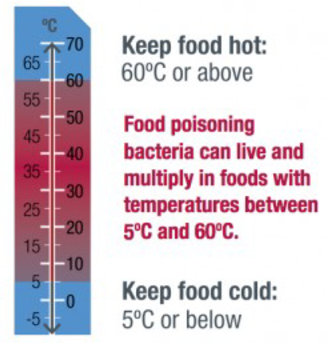Australian Food Safety Week will be held 9-16 November 2014. It is the major activity of the Food Safety Information Council, Australia’s leading disseminator of community targeted food safety information.
The theme for Australian Food Safety Week 2014 will be the Temperature Danger Zone †keeping hot food hot and cold food cold. Food poisoning bacteria can survive and grow rapidly if food is left out.in temperatures above 5°C and under 60°C.
‘

The Temperature Danger Zone for food lies between 5°C and 60°C because in this zone bacteria in food can grow and toxins can accumulate to unsafe levels within a few hours. If you hold hot food before serving it should be kept at 60°C or greater. We should always refrigerate or freeze cooked food that isn’t going to be eaten straight away and keep perishable food refrigerated under 5°C,’ Council Chair Dr Eyles said.
The Food Safety Information Council says you can avoid becoming one of the estimated 4.1 million cases of food poisoning in Australia each year by following these 7 simple tips to keep your food out of the Temperature Danger Zone:
1. Plan ahead. Don’t over cater as the greater the quantity of food you prepare the harder it is to keep it hot or cool enough. If you are catering for a lot of people prepare food as closely as you can to the time you will serve it.
2. Keep your fridge at or below 5°C. Use a fridge thermometer to check that the fridge temperature stays around 4 to 5°C. Also make sure you have enough room in the fridge because if the food is packed tightly the cold air cannot circulate.
3. Check the storage instructions. Read the label on packaged food to see if it needs to be stored in the fridge or freezer, many unrefrigerated items may need to be refrigerated once opened.
4. Keep hot food at or over 60°C. Hot food needs to be kept and served at 60°C or hotter. If you are keeping it warm for someone put it in the oven at 60°C (or at 100°C if that is as low as your oven will go).
5. Divide food up to cool. Freshly cooked food, not for immediate consumption, should have the temperature reduced as quickly as possible. Divide into containers in small portions and put it into the fridge or freezer as soon as it stops steaming.
6. Keep food on the move cool. If you are transporting perishable food around such as: refrigerated or frozen shopping, your (or your child’s) lunch or goodies for a BBQ or a picnic always use a cooler bag and add a frozen block or drink to keep things cool.
7. If in doubt throw it out. If perishable food has been in the temperature danger zone for 2 to 4 hours consume it immediately. After 4 hours throw it out.
For further information: www.foodsafety.asn.au
 Australian Food Safety Week is the major activity of the Food Safety Information Council which aims to address the estimated 4.1 million cases of food-borne illness in Australia each year. Food poisoning results, on average, in 31,920 hospitalisations, 86 deaths and 1 million visits to doctors each year.
Australian Food Safety Week is the major activity of the Food Safety Information Council which aims to address the estimated 4.1 million cases of food-borne illness in Australia each year. Food poisoning results, on average, in 31,920 hospitalisations, 86 deaths and 1 million visits to doctors each year.
Submitted by:
Lydia Buchtmann,
Food Safety Information Council


